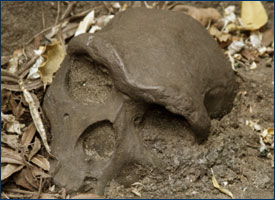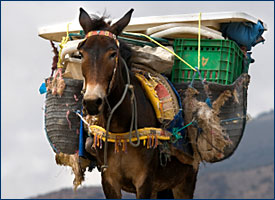Ecological Challenge: Overconsumption
Disasters and Solutions — Part 1
Ecological Challenge: Overconsumption
Back in the late 1980s we did an autopsy of the Exxon Valdez disaster. Six months following the terrible spill, we flew out to a remote beach in the Aleutian Islands only to find ourselves picking up massive scoops of undiluted oil. This was 2,000 miles from Valdez. Now, estimates suggest the oil will hit the Gulf currents and could potentially travel across the Atlantic, hitting Ireland, the UK, passing Gibraltar and transmigrating all the way to the coast of Israel, not to mention the devastation surrounding Hispaniola, Cuba, and most of the Caribbean hotspot locales.
 But back in the late 1980s, the Japanese Environmental Protection Agency (an offspring of the first EPA, created in the U.S. under the Nixon administration) had already determined that an approximately one millimeter of petroleum pollution covered the planet’s more than 70 percent marine environs. Moreover, some 10,000 oil and chemical spills were occurring every year, though were rarely mentioned in the media. Also in the late 1980s and early 1900s, NASA covered up the extent of the stratospheric ozone depletion rates, as the holes over Antarctica, and then the Arctic, as well as much of Australia, New Zealand, even the Swiss Alps and Southern California, grew larger and larger.
But back in the late 1980s, the Japanese Environmental Protection Agency (an offspring of the first EPA, created in the U.S. under the Nixon administration) had already determined that an approximately one millimeter of petroleum pollution covered the planet’s more than 70 percent marine environs. Moreover, some 10,000 oil and chemical spills were occurring every year, though were rarely mentioned in the media. Also in the late 1980s and early 1900s, NASA covered up the extent of the stratospheric ozone depletion rates, as the holes over Antarctica, and then the Arctic, as well as much of Australia, New Zealand, even the Swiss Alps and Southern California, grew larger and larger.
Now we add to this conservation conundrum, and the notion of a spiritual entity greater than our collective selves, the realization that we have indeed unleashed the previously referred to current extinction spasm and there would seem to be little comfort in the fact that Gaia, Mother Earth, may well be hoping and waiting for our species to disappear as quickly as possible. Indeed, our global fertility rates, still over three children per couple, on average, suggests that we will multiply in such quantities, translated into so massive a consumptive burden, as to all but denude every last place of wildness, every species that gets in our way, or can be consumed.
Of course, the Earth is also patient and, one might conclude, even understanding. Perhaps she recognizes, has even preconditioned our ecological schizophrenia. One can only pray that she will withstand the countless assaults on all sides; and that a representative selection of her precious life forms will survive our brief occupancy and usurpation of what biologists call Net Primary Production (“NPP”), that amount of green space (chlorophyll producing biomass) that we have usurped in our hell-bent, can-do insistence on optimizing the economics of the environment to suit our addiction to comfort. But who — other than great ecologists like Dr. Joyce Poole, or Dr. Marc Bekoff, or Dr. Con Slobodchikoff — have ever stepped back from those addictions to assiduously merge their psyches with those of elephants, coyotes and prairie dogs, so as to come out whole; to corroborate that brilliant message from Hegel that Sartre drew upon, namely, as prescribed in the ancient Greek definition of agape, that one’s soul is only expressed when it selflessly engages another’s soul; grants full moral status and appropriate reciprocity to all other life forms, as the Jain monks have come to emblemize.
Part 2: Biodiversity Successes and Failures
Comments Off

 Hegel, who enshrined the ideal of an ethical plane of action; a way by which — in spite of the nihilism encincturing our every motive, intention, action and restraint — we might yet redeem ourselves as individuals and as a species. But it will take stepping beyond the comfort zones of habit and embracing the true meaning of synderesis, moral action according to the Catholic interpretation; “spark of conscience” as referred to by the ancient Greeks. This is the same conscience at work some 60,000 years ago at the Shanidar Cave 3, in the Iraqi Zagros Mountains of Kurdistan, first excavated by a team from Columbia University during the period of 1957-1961. The first Neanderthal adult skeletons ever found had revealed that there had been a variety of ritual burials involving the placement of dried flower tiaras atop the skulls of the deceased there, amid rugged mountaintops. Perhaps a child first buried his or her parents. Whatever the circumstances, there is no question but that Ralph Solecki and his team had come upon the first known evidence that Neanderthal, who would intermarry and bear offspring with cotemporaneous Homo sapiens sapiens, thought deeply about the future with a sense of homage that carried over to their loved ones, a sense of conscience that involved the Earth herself. This is where Sartre departed from his otherwise unrelenting pessimism, borne no doubt in the wake of his having spent nine months in a Nazi prisoner of war camp. Sartre got off easy. Thirteen million others did not, prompting recent philosophers and theologians to not only question the existence of any god that would permit Holocausts, but to also give serious thought to the notion of conservation. Why bother, said Woody Allen, if all the homework in the world will be wiped out in an instant, whether in the form of a colliding asteroid, the implosion of the Earth herself in about four more billion years, or in the wake of what will likely prove to be the worst, most rapid extinction regime to date in this planet’s long history.
Hegel, who enshrined the ideal of an ethical plane of action; a way by which — in spite of the nihilism encincturing our every motive, intention, action and restraint — we might yet redeem ourselves as individuals and as a species. But it will take stepping beyond the comfort zones of habit and embracing the true meaning of synderesis, moral action according to the Catholic interpretation; “spark of conscience” as referred to by the ancient Greeks. This is the same conscience at work some 60,000 years ago at the Shanidar Cave 3, in the Iraqi Zagros Mountains of Kurdistan, first excavated by a team from Columbia University during the period of 1957-1961. The first Neanderthal adult skeletons ever found had revealed that there had been a variety of ritual burials involving the placement of dried flower tiaras atop the skulls of the deceased there, amid rugged mountaintops. Perhaps a child first buried his or her parents. Whatever the circumstances, there is no question but that Ralph Solecki and his team had come upon the first known evidence that Neanderthal, who would intermarry and bear offspring with cotemporaneous Homo sapiens sapiens, thought deeply about the future with a sense of homage that carried over to their loved ones, a sense of conscience that involved the Earth herself. This is where Sartre departed from his otherwise unrelenting pessimism, borne no doubt in the wake of his having spent nine months in a Nazi prisoner of war camp. Sartre got off easy. Thirteen million others did not, prompting recent philosophers and theologians to not only question the existence of any god that would permit Holocausts, but to also give serious thought to the notion of conservation. Why bother, said Woody Allen, if all the homework in the world will be wiped out in an instant, whether in the form of a colliding asteroid, the implosion of the Earth herself in about four more billion years, or in the wake of what will likely prove to be the worst, most rapid extinction regime to date in this planet’s long history. We are in trouble, all of us — every last woman and child, elephant and snail, seahorse and shark, monarch butterfly and gorilla. One fitting metaphor for this squandering of nature are the Caledonian Forests of Scotland, now reduced to some 35 tiny populations, or less than 1 percent of their original extant. These native pinewoods, survivors of the last Ice Age across the British Isles, responded to a warming trend by migrating north, into today’s Scotland. They comprised the western frontier of the great European boreal forests which today continue to provide nearly as much genetic resilience for the planet, as well as invertebrates and migratory birds, as the tropics. The Romans who first encountered the Caldeonian rown, birch, Scots pine, oak and juniper trees, also must have been wowed by the rich ensembles of other life forms crowding these heavenly outposts of temperate rainforest — nesting birds, glow worms, wild berries and mushrooms, deep pockets of moss, gorgeous lichens and ferns. The Romans called Scotland Caledonia which referred to both the local people, or Caledonii (the indigenous Picts, also called Britons) as well as the sylvan glens themselves, which were thought of as hearty and strong. The thought of their disappearance must never have occurred to the earliest human occupants of those woods. And one must wonder why it is, now, that we review the long biological history of such woods only to see that we are down to the final few groves. A similar revelation seems to pervade so much of biology that this generation must surely realize we are living in a time that is, for many of Earth’s tenacious life forms, more accurately the end of time. It was the Roman poet Eumenius, in AD 297 who first praised the Scottish locals and their beautiful environment. He would be disheartened and incredulous to wander across Scotland today. Oddly, though, human nature still looks at Scotland and sees great beauty. Does this mean we have the capacity to renew our faith and celebrate what’s left? Or that our conscience and aesthetic sensibilities have been so benumbed as to leave us without the powers of discernment?
We are in trouble, all of us — every last woman and child, elephant and snail, seahorse and shark, monarch butterfly and gorilla. One fitting metaphor for this squandering of nature are the Caledonian Forests of Scotland, now reduced to some 35 tiny populations, or less than 1 percent of their original extant. These native pinewoods, survivors of the last Ice Age across the British Isles, responded to a warming trend by migrating north, into today’s Scotland. They comprised the western frontier of the great European boreal forests which today continue to provide nearly as much genetic resilience for the planet, as well as invertebrates and migratory birds, as the tropics. The Romans who first encountered the Caldeonian rown, birch, Scots pine, oak and juniper trees, also must have been wowed by the rich ensembles of other life forms crowding these heavenly outposts of temperate rainforest — nesting birds, glow worms, wild berries and mushrooms, deep pockets of moss, gorgeous lichens and ferns. The Romans called Scotland Caledonia which referred to both the local people, or Caledonii (the indigenous Picts, also called Britons) as well as the sylvan glens themselves, which were thought of as hearty and strong. The thought of their disappearance must never have occurred to the earliest human occupants of those woods. And one must wonder why it is, now, that we review the long biological history of such woods only to see that we are down to the final few groves. A similar revelation seems to pervade so much of biology that this generation must surely realize we are living in a time that is, for many of Earth’s tenacious life forms, more accurately the end of time. It was the Roman poet Eumenius, in AD 297 who first praised the Scottish locals and their beautiful environment. He would be disheartened and incredulous to wander across Scotland today. Oddly, though, human nature still looks at Scotland and sees great beauty. Does this mean we have the capacity to renew our faith and celebrate what’s left? Or that our conscience and aesthetic sensibilities have been so benumbed as to leave us without the powers of discernment? We are a young species, possibly the youngest large mammalian collective in recent biological annals. Parrots and their ancestors have been around for well over 100 million years and can wield verb tenses and deep linguistic structure that far exceeds our clumsy efforts at communication, notwithstanding the fact English, for example, has well over 1.3 million words from which to pick and choose. Yet, some years ago, two independent studies revealed that the average American uses as few as fifty words on any given day. Similarly, the food we eat has been so homogenized as to render the teeming organic pharmacopeia that once graced most continents today largely sterile, monopolistic, and shorn of its biodiversity. Rare breed societies have pointed out that our apples, pears, peaches and bananas have been genetically altered, their constant hybridization a lump sum of denuded biomass consistent with our rage for efficiency. Taste, color and quality of our food, first stripped from its original sources and soils, has been refurbished with addulterants which — if one reads the labels — are astonishing for their complex chemical chicanery, mostly to ill-effect. In the same vane, developed countries have systematically sought out methods for maximizing profits at the expense of ecological insurance, diverse phenotypes, such that a single corn blight could easily wipe out a nation’s primary staple in a single season. Commerce and ecological diversity are at odds, when it should be the other way around. And in no more controversial arena is this dialectic argued and biased than that of animal rights.
We are a young species, possibly the youngest large mammalian collective in recent biological annals. Parrots and their ancestors have been around for well over 100 million years and can wield verb tenses and deep linguistic structure that far exceeds our clumsy efforts at communication, notwithstanding the fact English, for example, has well over 1.3 million words from which to pick and choose. Yet, some years ago, two independent studies revealed that the average American uses as few as fifty words on any given day. Similarly, the food we eat has been so homogenized as to render the teeming organic pharmacopeia that once graced most continents today largely sterile, monopolistic, and shorn of its biodiversity. Rare breed societies have pointed out that our apples, pears, peaches and bananas have been genetically altered, their constant hybridization a lump sum of denuded biomass consistent with our rage for efficiency. Taste, color and quality of our food, first stripped from its original sources and soils, has been refurbished with addulterants which — if one reads the labels — are astonishing for their complex chemical chicanery, mostly to ill-effect. In the same vane, developed countries have systematically sought out methods for maximizing profits at the expense of ecological insurance, diverse phenotypes, such that a single corn blight could easily wipe out a nation’s primary staple in a single season. Commerce and ecological diversity are at odds, when it should be the other way around. And in no more controversial arena is this dialectic argued and biased than that of animal rights. But the gentler traits of our upbringing have been largely ignored in our relationship to most other animal and plant species and this reality is obfuscated by the dreams of developers, manufacturers, job creation and Gross National Products that have failed to write down the quarterly profits and losses according to the obstruction or downright destruction of nature’s otherwise free services upon which we all depend, not least of which, some 80 percent of all medical cures or treatments deriving from the direct utilization of wild plant species, of which there are a known 400,000 or more. The brazen denial of the extinctions occurring at a vastly accelerated pace exceeding by at least a thousand times the “natural background rates” for extinction, must leave any feeling, thinking being in a state of utter panic. And yet, that panic is suffused within the age-old preoccupations with self-preservation. One cannot deny the truth of evolutionary pressures, punctuated equilibria, boom-and-bust population dynamics and the inevitability of death. We all eventually succumb to fears of mortality, in one form or other. But when we add to these basics the biased, typically invasive and vastly imperfect structure of scientific investigation, gap analysis of the breakdown in our ability to actually protect anything, whether the rich biomes of the Gulf of Mexico, the more than 4,000 U.S. designated Superfund sites, cities like Bhopal, the Gulf of Alaska, the wildlife across the tropical rainforests, the coral reefs and mangroves, the Tall Grass Prairies, and all those species on the brink of extinction, it becomes clear that individuals who would, otherwise, be intent upon doing their share to assist in the redemption of our collective undoing, are sapped of energy, inspiration, resources or the knowhow to navigate the politics, legalities, economics and community/biocultural values that argues for so many differing ethics, orientations, deities or lack thereof. We are, in other words, a species of total chaos. Our true selves have been reduced to what we term “the hypothetical species,” namely an ideal creature capable of resurrecting the paradise that is truly Earth, but seen only in Renaissance pastoral paintings, or movies like “Avatar.” Yet, even “Avatar” is odds with its value system: there are warriors, they are meat-eating and this indigenous habit is promoted within the overall vision of harmony. Yet, what is there philosophically to separate the killing of an innocent herbivore from the slaughter of an innocent tribe and their sacred trees?
But the gentler traits of our upbringing have been largely ignored in our relationship to most other animal and plant species and this reality is obfuscated by the dreams of developers, manufacturers, job creation and Gross National Products that have failed to write down the quarterly profits and losses according to the obstruction or downright destruction of nature’s otherwise free services upon which we all depend, not least of which, some 80 percent of all medical cures or treatments deriving from the direct utilization of wild plant species, of which there are a known 400,000 or more. The brazen denial of the extinctions occurring at a vastly accelerated pace exceeding by at least a thousand times the “natural background rates” for extinction, must leave any feeling, thinking being in a state of utter panic. And yet, that panic is suffused within the age-old preoccupations with self-preservation. One cannot deny the truth of evolutionary pressures, punctuated equilibria, boom-and-bust population dynamics and the inevitability of death. We all eventually succumb to fears of mortality, in one form or other. But when we add to these basics the biased, typically invasive and vastly imperfect structure of scientific investigation, gap analysis of the breakdown in our ability to actually protect anything, whether the rich biomes of the Gulf of Mexico, the more than 4,000 U.S. designated Superfund sites, cities like Bhopal, the Gulf of Alaska, the wildlife across the tropical rainforests, the coral reefs and mangroves, the Tall Grass Prairies, and all those species on the brink of extinction, it becomes clear that individuals who would, otherwise, be intent upon doing their share to assist in the redemption of our collective undoing, are sapped of energy, inspiration, resources or the knowhow to navigate the politics, legalities, economics and community/biocultural values that argues for so many differing ethics, orientations, deities or lack thereof. We are, in other words, a species of total chaos. Our true selves have been reduced to what we term “the hypothetical species,” namely an ideal creature capable of resurrecting the paradise that is truly Earth, but seen only in Renaissance pastoral paintings, or movies like “Avatar.” Yet, even “Avatar” is odds with its value system: there are warriors, they are meat-eating and this indigenous habit is promoted within the overall vision of harmony. Yet, what is there philosophically to separate the killing of an innocent herbivore from the slaughter of an innocent tribe and their sacred trees?  The term “animal rights” continues to elicit strong emotional reactions from those who oppose the notion that animals should have any legal standing whatsoever; that a tree is worth more alive than dead. The Swiss public that, until just recently had thought of itself as rather enlightened when it came to animal rights, recently threw out a remarkable referendum that would have provided every animal in need with a lawyer to speak on its behalf, the cost of such legal work to be born by the Swiss taxpayers.
The term “animal rights” continues to elicit strong emotional reactions from those who oppose the notion that animals should have any legal standing whatsoever; that a tree is worth more alive than dead. The Swiss public that, until just recently had thought of itself as rather enlightened when it came to animal rights, recently threw out a remarkable referendum that would have provided every animal in need with a lawyer to speak on its behalf, the cost of such legal work to be born by the Swiss taxpayers. Gripping storylines ripped from the newsstands and thousands of television and radio channels, not to mention Internet media escalate with a rapaciousness throughout the world, 24/7, inviting a collaboration in the ultimate voyeurism — computer cartography that yields imagery of your life and that of everyone else’s. In London, with its Internet Protocol surveillance cameras — an estimated 10,000 devices — has more than confirmed the fears raised by George Orwell about Big Brother. While in places like Mexico City, rifle-toting guards at every street corner engender a sense of a war zone.
Gripping storylines ripped from the newsstands and thousands of television and radio channels, not to mention Internet media escalate with a rapaciousness throughout the world, 24/7, inviting a collaboration in the ultimate voyeurism — computer cartography that yields imagery of your life and that of everyone else’s. In London, with its Internet Protocol surveillance cameras — an estimated 10,000 devices — has more than confirmed the fears raised by George Orwell about Big Brother. While in places like Mexico City, rifle-toting guards at every street corner engender a sense of a war zone.